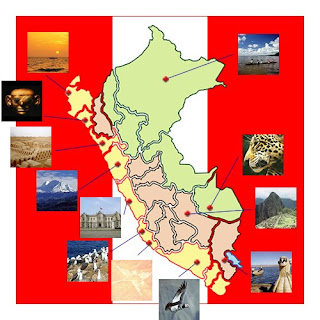
Peru (quechua: Piruw, Aymaran: Piruw), officially the Republic of Peru, is a country located in the western side of South America. It is limited by the north with Ecuador and Colombia, by the east with Brazil, the south-east with Bolivia, the south with Chile and the west with the Pacific Ocean. The Peruvian territory lodged to the civilization of Caral, one of oldest of the world, as well as to the Empire Inca, the greatest state of pre-Columbian America. Spain conquered its territory in century XVI and established a virreinato, which included its South American colonies most of. After to obtain its independence in 1821, Peru has spent per periods of political turbulence and fiscal crisis as well as per periods of stability and economic growth. Peru is a divided democratic presidentialist republic in 25 regions. Its geography varies from barren plains of the coast of the Pacific to
 tips of the mountain range of the $andes and the tropical forest of the amazonian, characteristic river basin that grants an ample variety to him of natural resources. It is a developing country with an Index of Human Development half and a level of 44% poverty. Their main economic activities include agriculture, fishes, the product mining and manufacture like the textiles. The Peruvian population, considered in 28 million, is of multi-ethnic origin and therefore of high degree of mestization. It includes native Americans, European, African and Asian. The spoken main language and more is the Spanish, although a significant digit of Peruvian speaks quechua and other native languages. This mixture of cultural traditions has been in an ample diversity of expressions in fields like the arts, cooks, Literature and music.
tips of the mountain range of the $andes and the tropical forest of the amazonian, characteristic river basin that grants an ample variety to him of natural resources. It is a developing country with an Index of Human Development half and a level of 44% poverty. Their main economic activities include agriculture, fishes, the product mining and manufacture like the textiles. The Peruvian population, considered in 28 million, is of multi-ethnic origin and therefore of high degree of mestization. It includes native Americans, European, African and Asian. The spoken main language and more is the Spanish, although a significant digit of Peruvian speaks quechua and other native languages. This mixture of cultural traditions has been in an ample diversity of expressions in fields like the arts, cooks, Literature and music.The territory of Peru encuenta determined by the plates South American and of Is born, which share a convergent limit of subduction, that is to say, the Plate of Is born subduccona on the South American parallel to the South American western coast, at a speed average of 11cm/año. Product of is subduction formed towards Jurassic the Grave of Peru-Chile as well as the today well-known elevation like Mountain range of the $andes. The erosion of the same has formed to the east a vast plain where before the appearance of the $andes was a portion of sea; this sedimentary region is the amazonian plain. That same erosive process is the cause of the escarped thing of the $andes. Due to the tectonic subduction, Peru is a highly seismic country and presents/displays regions with important vulcanism, mainly to the south. The Peruvian territory is within the call Fire Belt of the Pacific. Seismic movements The territory of Peru encuenta determined by the plates South American and of Is born, which share a convergent limit of subduction, that is to say, the Plate of Is born subduccona on the South American parallel to the South American western coast, at a speed average of 11cm/año. Product of is subduction formed towards Jurassic the Grave of Peru-Chile as well as the today well-known elevation like Mountain range of the $andes. The erosion of the same has formed to the east a vast plain where before the appearance of the $andes was a portion of sea; this sedimentary region is the amazonian plain. That same erosive process is the cause of the escarped thing of the $andes. Due to the tectonic subduction, Peru is a highly seismic country and presents/displays regions with important vulcanism, mainly to the south. The Peruvian territory is within the call Fire Belt of the Pacific. Seismic movements
In front of Peru one is located the Plate of Is born the one that next to the South American Plate forms atmosphere for earthquakes and earthquakes in the country. The earthquakes have been registered from the colony between which is the earthquake of the 31 of March of 1650 in Cusco related to the Gentleman of the Tremors, the earthquake of the 13 of November of 1655 that it allowed to the ample veneration of the Gentleman of the Miracles and the one of the 20 of October of 1687, that it destroyed great part of Lima, and that brought all a revolution in the construction technologies during the virreinato. Other earthquakes documented in Peru are the earthquake and tidal wave of the 28 of October of 1746; in this one marine disaster it took great part of the Pebble, the Earthquake of Arequipa of the 13 of August of 1868, the Earthquake of Lima and Pebble of the 24 of May of 1940, the earthquake of the Cusco of the 21 of May of 1950, the earthquake of Lima of the 17 of October of 1966, a day before the procession of the Gentleman of the Miracles, the earthquake and alluvium of the 31 of May of 1970, where the city of Yungay disappeared, the earthquake of Lima of the 3 of October of 1974, the earthquake of Arequipa of the 23 of June of the 2001, the earthquake of Moyobamba the 25 of September of the 2005, the earthquake of Lima of the 20 of October of the 2006 and Earthquake of Ica of the 15 of August of 2007.

Relief The main units of relief of Peru are the Mountain range of the $andes and the amazonian plain. The $andes initiate their slope in the depths of the Grave of Is born, but they ascend until near 6,700 ms being his altitude maximum the one of the snow-covered Huascarán (6,768 ms). The $andes do not form a constant slope, but multiple plateaus and deep valleys and guns separate the mountain range in diverse branches. To the south, this mountain range lodges the plateau of the Collao. On the feet of the $andes and towards the east of the mentioned mountain range the amazonian plain is located, which also expands by Bolivia, Brazil, Colombia, Ecuador and Venezuela. Climate Although its Earth location, in the strip of the tropical latitudes of the South hemisphere, would have to give him characteristic of the rainy very warm tropical in all the territory as it occurs in Eastern the amazonian plain and yungas, the certain thing is that in Peru thanks to geographic factors the great microclimate range is pronounced, many of which can be obervar less than in 2 hours of route. The first factor is the make to be located underneath the equatorial line and over the Tropic of Capricorn, granting to him a sun and tropical and/or subtropical atmosphere to all the Peruvian region. The second factor is the mountain range of the $andes (very injured and elevated in this American region South) that atreviesa the territory of the south to north. The third factor is the influence of the cold ocean current of Humboldt, who indicates in the norcentral and South coast with a reduction in the annual temperature in ten degrees Celsius and the almost total precipitation absence. Finally, the fourth factor is the warm current of the Boy, who indicates in the North coast every ten years with an impact in the climate and precipitations at global level. These factors bring about a series of microclimates within the Peruvian territory .
Departments of Peru :

Amazonas
Ancash
Apurímac
Arequipa
Ayacucho
Cajamarca
Cusco
Huancavelica
Huánuco
Ica
Junín
La Libertad
Lambayeque
Lima
Loreto
Madre de Dios
Moquegua
Pasco
Piura
Puno
San Martín
Tacna
Tumbes
Ucayali








No hay comentarios:
Publicar un comentario